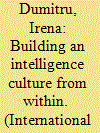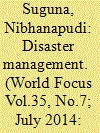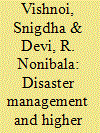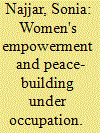|
|
|
Sort Order |
|
|
|
Items / Page
|
|
|
|
|
|
|
| Srl | Item |
| 1 |
ID:
132436


|
|
|
|
|
| Publication |
2014.
|
| Summary/Abstract |
Collective perceptions on intelligence services have been for centuries associated with a sense of mystery, obscurity, and clandestine behavior. At the same time, intelligence success could not be traditionally conceived and exercised in the absence of cover, duplicity, truth manipulation, and intentional avoidance, as well as of masks adapted to context. Therefore, intelligence would traditionally be based on secrecy and a mainly "no communication" approach. Thus, secrecy inherently marked intelligence, as both a barrier created from inside the organization towards the outside world and as a label placed by public opinion on the intelligence organization, therefore shaping knowledge of what cannot otherwise be known.
|
|
|
|
|
|
|
|
|
|
|
|
|
|
|
|
| 2 |
ID:
132497


|
|
|
|
|
| Publication |
2014.
|
| Summary/Abstract |
Hundreds of Natural disasters take place worldwide every year causing irreparable damage to life and property. Earthquakes, ?oods, typhoons, hurricanes,- Tsunamis are among the worst of these natural disasters. Over the last few decades, there has been an alarming increase in the occurrence of natural disasters and the magnitude of their social, economic and environmental impact. During any natural disaster it is usually the" children who suffer the most. The nation witnessed the death of nearly a thousand children during the 2001 Bhuj earthquake. Out of them, 300 died while marching for the Republic day parade. They were in a narrow lane when the earthquake hit causing buildings onboth sides to collapse. It is said thatpnearly 1,884 school buildings collapsed leading to a loss of 5,950 class rooms. About 12000 schools suffered damages making them un?t for children to continue their studies. Fire tragedies, like the one in Kurnbakonam killed 93 children in a school. Another ?re accident in Dabwali, Haryana where a ?re broke out during a schoolfunction took he lives of many school children. Children in schools are the 'most vulnerable group during any disaster. These tragedies reiterate the need for all of us to sit up and think about the safety of these children. It is necessary to make schools safe and hazard proof. For this purpose, it is important to have disaster management, emergency preparedness and response plans at school level.
|
|
|
|
|
|
|
|
|
|
|
|
|
|
|
|
| 3 |
ID:
132496


|
|
|
|
|
| Publication |
2014.
|
| Summary/Abstract |
School and higher education has received a very important place in the l2 " Plan document submitted by the working group on disaster management'. There is a paradigm shift in the approach of this document as it has not only earmarked adequate funding for school and higher education, technical education and medical education, but has for the first time tried to use the human resources in a fruitful manner. While the 12"education lists major initiatives which needs to be taken, it has yet to specify the road map for successful. implementation of the recommendations outlining speci?c roles that various stakeholders may play. The Department of Anthropology, University of Delhi, organized a one day seminar to critically examine the document of 12* Five Year Plan with special reference to the 'role of higher education in disaster management.' Ahumble introduction of the chairperson Prof. Vinay Kumar Srivastava, former Principal, Hindu College, and other distinguished speakers, which included Prof. R. B. Singh, Vice President International - Geography Union; Dr. Ranjana Mukhpadhyay, Chairperson, Samutthan Eoundation; Dr Urfat Anjem Mir, Ambedkar University, New Delhi; Dr. Angeli Qwatra, Philanthrope, New Delhi; Dr. Sunita Reddy, Jawaharlal Nehru_University; Prof. V. R. Rao, former Director, Anthropological Survey of India was provided to the audience sharing the expertise and interests of each one of them. Prof. P.C Joshi, Asia Coordinator, EU Integrated Project MICRODIS and President, Society for Indian Medical Anthropology, initiatedthe discussion by sharing the concern of thinking of ways of mainstreaming disaster education at various levels and cadres. It was emphasized to discuss the role and capacities of universities in particular to impart awareness, and support action towards the -same.
|
|
|
|
|
|
|
|
|
|
|
|
|
|
|
|
| 4 |
ID:
130504


|
|
|
|
|
| Publication |
2011.
|
| Summary/Abstract |
As a contribution to the discussion on women's empowerment in the Palestine-Israel Journal, this article reflects on the possibilities for women's empowerment and peace-building under a condition of prolonged occupation. Specifically, it focuses on the near-impossibility of the manifestation of empowerment and peace for those who have been disenfranchised under a paradigm of extreme oppression in the context of Occupied Palestine. If one uses Eileen Kuttab's contextualization of Palestinian empowerment as historically being embodied in practices of mobilization and resistance, then being allowed neither mobility nor the right to organize resistance to Israeli military violence makes it clear that the prospects for successful peace-building and the realization of Palestinian women's empowerment face significant obstacles.1 This is a result of the autocratic imbalance of power that has seeped from external into internal dynamics. The external factors are the architects and participants of the occupation comprised of an illegal Israeli military occupation force of women and men, abetted by an international community that does not adhere to its mandates to the fullest extent and follows an aid praxis that further serves to annihilate mobilization and resistance. The internal obstacles to women's empowerment are an extension of the external, that is, elements of the Palestinian local governing structure that was meant to be temporary in nature.
|
|
|
|
|
|
|
|
|
|
|
|
|
|
|
|
|
|
|
|
|